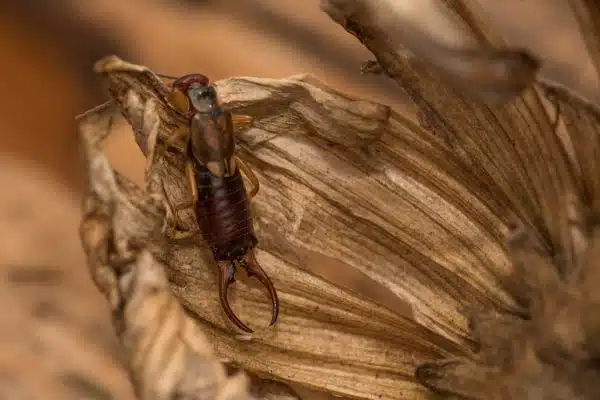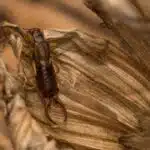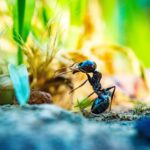Earwigs, also known as pincher bugs, are a common garden pest that can wreak havoc on your plants and vegetables. These small insects are easily recognizable by their long pinchers at the end of their abdomen. While earwigs are not harmful to humans, they can cause significant damage to your garden if left unchecked. In this article, we will explore different methods for getting rid of earwigs in your garden.
Earwigs are attracted to moist environments and tend to hide in dark places during the day, such as under rocks or plant debris. They are most active at night when they feed on leaves and stems of plants. Earwigs can also cause damage to fruits and vegetables by feeding on them or leaving behind their excrement which attracts other pests. It is essential to take preventative measures early on to prevent an infestation from occurring. By following some simple steps and using natural remedies, you can effectively get rid of earwigs in your garden without harming the environment or other beneficial insects.
Identifying Earwigs And Their Behavior
Earwigs, also known as pincher bugs or forceps bugs, are common garden pests that belong to the order Dermaptera. They are characterized by their long, slender bodies and pincers on their rear end. Earwigs range from 1/4 inch to 1 inch in length and come in a variety of colors such as brown, black, and reddish-brown. These insects are nocturnal and can be found hiding under rocks, plant debris, or in cracks during the day.
Earwigs have a unique life cycle that involves three stages: egg, nymph, and adult. The eggs are laid in moist soil or other organic matter and hatch within a week or two. The nymphs look like small versions of adults but lack wings and reproductive organs. They go through several molts before reaching adulthood. Earwig lifespan varies depending on species but generally lasts for one year.
Earwigs are omnivores that feed on both plant and animal material. They prefer decaying plant matter but will also eat live plants if other food sources are scarce. While earwigs may not cause significant damage to plants alone, they can attract other pests such as aphids and mites that can harm crops. Therefore, early detection and control measures are necessary to prevent an infestation from becoming severe and causing significant damage to your garden.
The Importance Of Early Detection
Just as a watchful sentry is vital to the safety of a castle, early detection is crucial in the management of earwig populations. Gardeners must remain vigilant and aware of the signs of an infestation to prevent any potential damage to their plants. The earlier you detect and address an earwig problem, the easier it will be to manage.
Early detection involves paying close attention to your plants, especially those that are most susceptible to earwig damage. Inspect them regularly for signs of feeding damage or irregular growth patterns. Keep an eye out for earwigs themselves, which often come out at night and hide during the day. If you find them under rocks or other debris in your garden, it’s likely that they have established a nest nearby.
Managing earwig populations can be challenging but not impossible. Once you have detected their presence, there are several methods you can use to reduce their numbers. These include using traps, applying insecticides, or using natural predators like birds and spiders. However, these methods are most effective when applied early on in an infestation before populations become too large.
Transition: While managing earwig populations is important for protecting your garden from harm, removing attractants from your garden can also be helpful in preventing future infestations.
Removing Attractants From Your Garden
Attractant control is an effective way to keep earwigs at bay. Earwigs are attracted to moist environments and decaying plant matter, so removing these attractants will help reduce their population. Regularly cleaning up fallen leaves, weeds, and other debris from the garden will also help eliminate potential hiding spots for earwigs.
Plant selection can also play a role in reducing earwig populations. Opting for plants that are less attractive to earwigs, such as marigolds or lavender, can be helpful. Additionally, planting herbs like basil or rosemary around the perimeter of the garden can act as a natural deterrent for earwigs.
It’s important to note that while these methods may help reduce the presence of earwigs in your garden, they may not completely eliminate them. However, incorporating attractant control measures and choosing certain plants can greatly reduce their numbers and minimize any damage they may cause to your plants.
Keeping Your Garden Dry
- Watering your garden in the morning is an effective way to ensure the soil does not remain too moist.
- Ensuring proper drainage in the garden environment is critical to avoid excess moisture that may attract earwigs.
- Mulching around plants can also help to keep the soil dry, while also providing important nutrients to the plants.
- Avoiding overwatering is key as an overly moist soil environment is an ideal habitat for earwigs.
- Aerating soil can help to improve the circulation of air and reduce excessive moisture.
- Using an appropriate drainage system can be beneficial to keep garden beds dry and prevent waterlogging.
Watering In The Morning
When it comes to keeping your garden dry and free from earwigs, one effective method is watering in the morning. This technique ensures that the plants receive adequate moisture before the sun becomes too hot, while also allowing excess water to evaporate before nightfall. The benefits of morning watering go beyond simply preventing earwig infestations, as it promotes healthy plant growth and reduces the risk of fungal diseases.
However, for those who prefer not to water in the morning, there are alternative methods for controlling earwigs in your garden. One such option is using sticky traps or bait stations to attract and eliminate these pests. Additionally, removing any debris or hiding spots where earwigs may reside can help discourage their presence in your garden. It is important to note that while these alternatives may be effective, they do not offer the same benefits as morning watering for overall plant health.
In conclusion, while there are alternative methods available for controlling earwigs in your garden, watering in the morning remains a highly recommended technique for promoting healthy plant growth and reducing pest infestations. By incorporating this practice into your gardening routine, you can enjoy a thriving garden that is free from unwanted visitors.
Providing Proper Drainage
Improving drainage is a crucial aspect of water management in gardens, as it plays an essential role in maintaining soil moisture levels and promoting plant health. Poor drainage can lead to waterlogging, which can suffocate roots and create an environment that is conducive to fungal diseases. Additionally, stagnant water can attract pests like earwigs, who thrive in moist environments.
To provide proper drainage in your garden, start by assessing the soil type and structure. Heavy clay soils tend to retain water for longer periods compared to sandy soils that drain more quickly. If your soil is predominantly clay, consider incorporating organic matter like compost or well-rotted manure to improve its structure and increase porosity. Alternatively, you can install drainage tiles or raised beds with well-draining soil mixtures.
Another effective approach to improving drainage is by creating slopes or mounds that allow excess water to flow away from the plants’ roots. This technique is particularly useful for gardens located in low-lying areas prone to flooding or heavy rainfall. By providing proper drainage, you not only prevent water damage but also discourage earwig infestations that are attracted by stagnant water.
Providing proper drainage is a critical component of water management in gardens that promotes healthy plant growth and reduces earwig infestations. Whether you opt for organic amendments or physical structures like raised beds, ensuring adequate moisture levels and preventing waterlogging is key to maintaining a thriving garden ecosystem. By prioritizing good drainage practices alongside other techniques like morning watering, you can enjoy a pest-free garden filled with vibrant, healthy plants.
Avoiding Excess Moisture
Another crucial aspect of keeping your garden dry is avoiding excess moisture. While proper drainage is essential, it’s equally important to ensure that you’re not overwatering your plants or allowing water to accumulate in areas where it shouldn’t. Excess moisture can create a breeding ground for pests like earwigs, who seek out damp environments and thrive in high humidity.
One effective way to control moisture levels in your garden is by using a watering schedule that takes into account the specific needs of each plant. Some plants require more frequent watering than others, while some may need less water altogether. By identifying these differences and adjusting your watering accordingly, you can prevent overwatering and reduce the risk of creating ideal conditions for earwig infestations.
Another technique for avoiding excess moisture is by mulching around your plants with materials like straw, wood chips, or shredded leaves. Mulch helps regulate soil temperature and prevents water from evaporating too quickly, which can be particularly beneficial during hot summer months. However, it’s important not to over-mulch as this can lead to excessive moisture buildup and encourage pests like earwigs. By following these guidelines and paying close attention to moisture levels in your garden, you can enjoy healthy, thriving plants without worrying about pest infestations.
Trapping Earwigs With Newspaper Or Cardboard
Trapping earwigs with newspaper or cardboard is a popular DIY method for gardeners. The idea behind this technique is to create a hospitable environment for earwigs to hide in, and then trap them in the material. This can be an effective way of reducing the number of earwigs in your garden.
One alternative to using newspaper is corrugated cardboard, which can also work well as a trap. In fact, some gardeners prefer cardboard because it tends to last longer than newspaper and does not disintegrate as quickly. To use cardboard as a trap, simply cut it into strips or squares and place it around the garden where earwigs are known to congregate.
DIY earwig traps can be made in a variety of ways using materials such as flowerpots, plastic containers, or tin cans. The key is to create a dark, moist environment that will attract earwigs. Once they have entered the trap, they will not be able to climb out due to the smooth sides of the container. After trapping the earwigs, dispose of them by shaking them out into a bucket of soapy water or releasing them outside of your garden area.
Moving on from trapping earwigs with newspaper alternatives and other DIY options, another effective method for controlling these pests involves placing rolled up newspapers in your garden beds. This technique works by providing a hiding place for earwigs during the day when they are most vulnerable to predators like birds and other insects. By rolling up newspapers tightly and placing them strategically throughout your garden beds, you may be able to reduce the number of earwigs present over time.
Placing Rolled Up Newspaper In Garden Beds
The placement of rolled newspaper in garden beds is an effective way of trapping and eliminating earwigs. Paper should be rolled into tight cylinders and placed around the perimeter of the beds, as well as around each individual plant. The newspaper should be replaced regularly to maintain its effectiveness. Garden beds should be checked often for the presence of earwigs and the rolled up paper should be removed and replaced with fresh paper as needed. In addition to providing a physical barrier, the rolled newspaper also acts as a food source for the earwigs, luring them into the paper for easy removal. Finally, the paper should be replaced with fresh paper when it becomes saturated with moisture, as this will reduce its effectiveness.
Placement
Garden design is an essential aspect of landscaping that involves the placement of plants, structures, and features. When it comes to pest control, garden design can play a crucial role in reducing the population of earwigs in your garden. One effective method is placing rolled up newspaper in garden beds.
To effectively use this method, consider the placement of the newspapers. It’s best to place them in areas where earwigs are most likely to hide or travel through. These include under pots, near walls or fences, and in damp areas where they thrive. However, avoid placing them directly on top of plants as they may damage them and make sure they are secure to prevent them from blowing away.
Another way to optimize this method is by combining it with other pest control techniques such as removing debris and clutter around your garden beds. This will eliminate potential hiding places for earwigs and reduce their population even further. By applying these strategies strategically within your garden design, you’ll have a more effective approach to pest control that won’t harm beneficial insects or plants.
In summary, placing rolled up newspaper in your garden beds can be an effective method for controlling earwig populations. To maximize its effectiveness, consider its placement within your garden design and combine it with other pest control techniques. With these strategies in place, you’ll create a healthy and thriving environment for your plants without relying on harmful pesticides or chemicals.
Rolled Newspaper
Earwigs can be a nuisance in gardens as they feed on plants, fruits, and flowers. Using rolled newspaper to control earwigs is an effective and environmentally friendly method that has gained popularity among gardeners. In addition to its primary role of providing information, newspapers have alternative uses in the garden.
By rolling up newspapers and placing them in strategic areas within the garden bed, you can create hiding places for earwigs. The earwigs will crawl into the newspaper rolls and can be easily disposed of by collecting and discarding the papers in a sealed trash bag. This method is particularly useful for small gardens or areas where earwig infestations are localized.
Aside from controlling pests like earwigs, newspapers can also serve other purposes in the garden. They can be used as a weed barrier by layering them between soil and mulch or as a natural composting material when shredded and mixed with other organic materials. Moreover, newspapers can be used to protect plants from frost damage by wrapping them around plant stems before covering them with plastic or cloth. With these alternative uses, newspapers are not only useful for reading but also for maintaining a healthy garden environment.
Garden Beds
Garden beds are a crucial component of any garden, as they provide an organized and efficient way to grow plants. However, maintaining healthy garden beds can be challenging due to various factors such as soil quality, pests, and weeds. To address these issues, gardeners often use mulching techniques and companion planting to promote plant growth and deter pests.
One effective strategy for controlling pests in garden beds is by placing rolled-up newspapers in strategic areas. The newspapers serve as hiding places for earwigs and other pests that may damage plants. By collecting and discarding the papers in sealed trash bags, gardeners can effectively remove these pests without harming the environment. Additionally, using newspapers as a weed barrier or composting material can help maintain healthy soil in the garden bed.
Incorporating companion planting into garden bed design is another useful technique for maintaining healthy plants. Companion planting involves growing different crops together that have beneficial relationships with each other. For example, planting marigolds alongside vegetables like tomatoes can help repel nematodes and other harmful insects while attracting beneficial insects like ladybugs. This technique not only improves plant health but also reduces the need for chemical pesticides that may harm the environment.
By incorporating strategies such as placing rolled-up newspapers in garden beds and implementing companion planting techniques, gardeners can maintain healthy gardens while minimizing environmental impact. These practices not only benefit individual gardens but also contribute to a healthier ecosystem overall.
Creating Homemade Traps With Soy Sauce Or Oil
While some may find earwigs to be harmless insects, they can quickly wreak havoc on a garden. These creepy crawlies have a particular affinity for tender young plants and flowers. If left unchecked, an earwig infestation can decimate a garden in no time. Fortunately, there are several DIY earwig traps that you can make using household items.
One of the most effective methods for trapping earwigs is by using soy sauce or oil. Simply fill a shallow dish with either substance and place it around the garden bed. The earwigs will be attracted to the smell and will fall into the trap, unable to climb out. Be sure to check and empty these traps regularly to keep them from overflowing.
Another homemade trap that works well is using rolled up newspaper. Earwigs love tight spaces, so rolling up newspaper creates an ideal spot for them to hide during the day. Place these rolls near areas where you’ve noticed high levels of earwig activity, such as under pots or between rows of plants. By checking these traps daily and disposing of any trapped earwigs, you can significantly reduce their numbers in your garden.
Earwig prevention tips for gardeners include keeping your garden area clean and tidy, removing debris such as leaves or grass clippings that could serve as hiding spots for these pests. Additionally, planting herbs like mint or basil can repel earwigs due to their strong scent. By implementing these tactics alongside DIY earwig traps, you can help keep your precious plants safe from these pesky insects.
To further protect your garden from harmful pests like earwigs, consider using diatomaceous earth as a natural insecticide. This powdery substance is made from fossilized remains of tiny aquatic organisms called diatoms. When sprinkled around affected areas in your garden, it dehydrates insects upon contact causing them to die off quickly without harming beneficial insects or animals in the environment.
Using Diatomaceous Earth As A Natural Insecticide
Diatomaceous earth is a natural insecticide that can be used to control earwigs in your garden. This fine powder is made from the fossilized remains of diatoms, and it works by dehydrating insects when they come into contact with it. To apply diatomaceous earth to your garden, sprinkle a thin layer around the base of plants or areas where earwigs are present. Be sure to wear a dust mask and gloves to protect yourself from inhaling the powder.
While diatomaceous earth is effective against earwigs, it may not be as potent as other natural insecticides. For example, neem oil has been shown to repel earwigs and other pests while also providing some plant nutrition benefits. However, diatomaceous earth is often preferred by gardeners who want an option that is safe for beneficial insects like bees and ladybugs.
When using diatomaceous earth, it’s important to take safety precautions to prevent inhalation or skin irritation. Always wear gloves and a dust mask when handling the powder, and avoid applying it on windy days to prevent it from blowing into your face. Additionally, keep pets and children away from treated areas until the powder has settled into the soil. By following these guidelines, you can safely use diatomaceous earth as a natural insecticide in your garden.
Transition: Now that we’ve discussed how to use diatomaceous earth for controlling earwigs in your garden, let’s explore another natural remedy: applying neem oil.
Applying Neem Oil To Repel Earwigs
To prepare a neem oil solution suitable for repelling earwigs, a horticulturalist must first dilute neem oil with water, using a ratio of 1 tbsp of neem oil to 1 gallon of water.
The diluted solution should then be agitated to ensure that it is properly mixed and ready for use.
To apply the neem oil solution to repel earwigs, a horticulturalist should use a sprayer to evenly coat affected areas of the garden.
After application, it is important to monitor the earwig activity in the garden in order to determine the effectiveness of the neem oil solution.
To monitor earwig activity, a horticulturalist should routinely check for signs of earwigs in the garden such as silverfish, roly polys, and sowbugs.
If the neem oil solution is found to be ineffective, a horticulturalist may need to reapply the neem oil solution more frequently or consider alternative methods of repelling earwigs.
Preparing Neem Oil Solution
To repel earwigs in your garden, one effective solution is to use neem oil spray. Neem oil, derived from the seeds of the neem tree, contains compounds that act as a natural insecticide. Mixing neem oil with water and a few drops of dish soap creates an easy-to-apply and safe solution for your garden.
Preparing neem oil spray involves a simple process. First, mix 1-2 tablespoons of pure neem oil with a gallon of water in a spray bottle or tank sprayer. Then, add a few drops of dish soap to help the mixture stick to plant surfaces. Finally, shake well and apply the solution directly onto plants where earwigs are present.
It’s important to note that while neem oil is safe for humans and pets, it can harm beneficial insects like bees if used excessively. Therefore, it’s recommended to only use neem oil spray when necessary and apply it during times when bees are less active, such as early morning or late evening. By following these steps for preparing neem oil spray, you can effectively repel earwigs from your garden without harming other organisms in the ecosystem.
Applying Neem Oil
Neem oil is a natural and effective way to repel earwigs from your garden. This oil contains compounds that act as a natural insecticide, making it an excellent choice for those who want to avoid using synthetic chemicals. Apart from its effectiveness in keeping pests away, neem oil has other benefits for plants, such as promoting growth and preventing diseases. It’s also safe for humans and pets, making it a great alternative to harmful pesticides.
When applying neem oil to your garden, there are several ways to do it effectively. One of the best ways is to mix neem oil with water and dish soap to create a spray solution that can be easily applied directly onto plants where earwigs are present. Another effective method is to use neem cake or pellets, which can be mixed into the soil around plants or added to compost. This method not only repels earwigs but also provides nutrients for the soil.
Before applying neem oil or any other pest control solution, it’s important to identify the type of pest you’re dealing with and understand its behavior and habitat. This will help you determine the best approach for controlling it without harming beneficial insects or plants. By following these best practices for applying neem oil in gardening, you can effectively protect your garden from earwig damage while promoting healthy plant growth and maintaining a balanced ecosystem.
Monitoring Earwig Activity
After applying neem oil to your garden, it’s important to monitor earwig activity regularly. Earwigs are active at night and tend to hide during the day in damp areas such as under rocks, logs, or debris. Therefore, checking these areas for earwig activity is essential. You can also use traps such as rolled up newspapers or cardboard tubes filled with straw or a similar material to attract earwigs and then dispose of them in the morning.
Observing earwig behavior can also help you determine if they are present in your garden. Earwigs are known to feed on plants, fruits, and vegetables, leaving behind ragged holes and bite marks. They may also feed on other insects and their eggs, which can be beneficial for your garden. However, if their population grows too large, they can become a nuisance and cause damage to your plants.
Garden monitoring is an ongoing process that helps you maintain a healthy ecosystem while preventing pest damage. By using neem oil and monitoring earwig activity regularly, you can effectively control their population without harming beneficial insects or plants. This approach not only protects your garden but also promotes sustainable gardening practices that benefit both you and the environment.
Spraying Insecticidal Soap As A Safe Alternative
As an alternative to harsh chemicals, spraying insecticidal soap can effectively control earwigs in your garden. Insecticidal soap is a natural and safe option that can be used on a wide variety of plants without causing harm. It works by penetrating the waxy outer layer of insects, causing dehydration and ultimately leading to their demise.
One of the benefits of using insecticidal soap is that it is environmentally friendly and does not harm beneficial insects such as bees or ladybugs. It also does not leave any harmful residue on the plant or soil, making it safe for consumption after application. In addition, it is easy to use and readily available at most garden centers.
When using insecticidal soap, it is important to follow safety measures to ensure proper application. Read the label carefully before use and wear protective clothing such as gloves and goggles. Avoid spraying during periods of high heat or direct sunlight as this can cause damage to the plant. Be sure to apply evenly to all areas where earwigs may be present, including under leaves and in crevices.
By utilizing insecticidal soap as a natural and safe alternative, you can effectively control earwigs in your garden without harming beneficial insects or leaving harmful residue behind. However, if you prefer a more hands-off approach, consider using beneficial insects to control earwig populations in your garden.
Using Beneficial Insects To Control Earwigs
Beneficial insects can be a great ally in controlling earwigs in your garden. Partnering with ants can be particularly effective, as they are natural predators of earwigs. Ants will not only help to control the population of earwigs but also other pests such as aphids and caterpillars. To attract ants to your garden, provide them with a source of food such as sugar water or honeydew-producing plants like milkweed.
Companion planting is another effective method for controlling earwig populations. Planting certain herbs and flowers like calendula, yarrow, and dill around your garden can help to repel earwigs and other pests. These plants have strong scents that act as a natural insecticide, keeping pests at bay while promoting healthy plant growth.
Using beneficial insects and companion planting are both effective methods for controlling earwig populations in your garden. By partnering with ants and planting herbs and flowers that repel pests, you can reduce the need for harmful pesticides while promoting a healthy ecosystem in your garden. In the next section, we will discuss another method for removing earwigs by hand.
Removing Earwigs By Hand
As a horticulturalist, I know that removing earwigs by hand is one of the most effective ways to eliminate them from your garden. However, this process can be time-consuming and requires patience. It’s important to note that earwigs are nocturnal insects that are attracted to damp areas and hide during the day in dark crevices such as under pots or debris.
When removing earwigs by hand, it’s essential to wear gloves. Gloves provide protection against any potential harm caused by these insects. The benefits of gloves extend beyond just protecting your hands; they also help prevent the spread of bacteria and other pathogens found in soil. Additionally, wearing gloves helps minimize damage done to plants during the removal process.
Understanding the earwig life cycle is crucial when attempting to remove them from your garden. Earwigs lay their eggs in moist soil during the fall months, which hatch into small nymphs in spring. These nymphs mature within a few months and can live up to a year or longer depending on environmental conditions. Removing adult earwigs before they lay eggs is essential for preventing future infestations.
Properly Disposing Of Earwigs
Once you have successfully trapped or collected earwigs from your garden, it is important to dispose of them properly. Simply throwing them in the trash or compost pile may seem like an easy solution, but it can have negative environmental impacts. Earwigs are not native to many areas and can become invasive if introduced to a new environment. Additionally, they may attract other pests such as rodents or birds that feed on them.
To properly dispose of earwigs, it is recommended to release them at least 100 yards away from your garden or home. This distance ensures that they will not find their way back and cause further damage. If you do not have access to an appropriate area for release, consider placing the earwigs in a sealed plastic bag and leaving them in direct sunlight for several hours. The heat will kill the earwigs and prevent them from causing harm elsewhere.
It is important to remember that even though earwigs can be seen as pests, they still play a role in the ecosystem and should be treated with respect. Properly disposing of them without causing harm to other organisms is crucial for maintaining balance in your garden and surrounding environment.
Transition into Monitoring Your Garden: Now that you know how to properly dispose of earwigs, it’s important to monitor your garden regularly for signs of infestations. By catching an infestation early on, you can prevent significant damage to your plants and reduce the need for drastic measures such as pesticides. In the next section, we will discuss how to identify potential problem areas in your garden and implement preventative measures against future infestations.
Monitoring Your Garden For Signs Of Earwig Infestations
Despite their name, earwigs do not actually crawl into people’s ears. However, they can still be a nuisance in your garden and cause damage to your plants. It is important to monitor your garden for signs of earwig infestations in order to prevent them from causing further harm.
One way to identify the presence of earwigs in your garden is by observing the damage that they cause. Earwigs feed on leaves, flowers, and fruit, leaving behind irregular holes and chew marks. They also tend to congregate in dark, damp places such as underneath rocks or inside plant debris. If you notice these signs in your garden, it may be time to take action.
In addition to monitoring for signs of infestation, there are steps you can take to prevent earwigs from entering your home. One tip is to seal up any cracks or crevices around doors and windows that might allow them entry. You can also remove any excess vegetation or debris from around the perimeter of your home. By taking these preventative measures, you can ensure that earwigs stay out of your living space and remain confined to your garden.
To prevent future earwig infestations in your garden, it is important to establish a regular maintenance routine. This includes removing weeds and dead plant matter regularly as well as keeping the soil moist but not overly wet. Additionally, you can introduce natural predators such as birds or insects that feed on earwigs into your garden ecosystem. By following these tips and monitoring for signs of infestation regularly, you can keep earwigs at bay and enjoy a healthy garden all season long.
Preventing Future Earwig Infestations
Garden maintenance is crucial in preventing future earwig infestations. A tidy garden can discourage earwigs from making a home in your outdoor space. Regularly removing debris, fallen leaves, and dead plants can reduce the number of hiding spots for these pests. Mulch, which is a favorite hiding spot for earwigs, should be kept at a minimum to prevent them from breeding.
Pest control techniques are also essential in keeping earwigs away from your garden. Using sticky traps and insecticides that target earwigs can reduce their population. However, it is important to remember that these methods may harm other beneficial insects as well. Therefore, using natural repellents such as diatomaceous earth or neem oil may be a better option.
In addition to regular garden maintenance and pest control techniques, one can use physical barriers to keep earwigs away from specific plants or areas of the garden. Placing copper strips around the base of plants or using rolled-up newspaper traps can prevent earwigs from reaching their desired location. Overall, a combination of preventative measures and targeted pest control techniques can help ensure that your garden remains free of earwig infestations for years to come.
Conclusion
Earwigs are a common garden pest that can cause damage to plants and vegetables. Identifying their behavior and early detection are crucial in preventing an infestation. Removing attractants such as decaying organic matter and keeping the garden dry can help deter earwigs. Trapping them with newspaper or cardboard and removing them by hand are effective methods of control, but proper disposal is necessary. Regular monitoring of the garden for signs of infestation is important to prevent future outbreaks.
According to a study conducted by the University of California, earwig populations can reach up to 100 individuals per square meter in some gardens. This highlights the importance of early detection and prevention measures in controlling their population. As horticulturalists, it is our responsibility to educate gardeners about the potential damage caused by earwigs and provide effective solutions for control.
In conclusion, identifying, detecting, and preventing earwig infestations in your garden is critical for maintaining healthy plants and vegetables. By removing attractants, keeping the garden dry, trapping them with newspaper or cardboard, removing them by hand, properly disposing of earwigs, monitoring the garden regularly, and taking preventative measures, you can control earwig populations effectively. It is essential to remember that prevention is key in managing pests like earwigs and ensuring a thriving garden for years to come.
Image Credits
- “Is there beauty in an earwig?” by NedraI (featured)





























